
If you’re struggling with bad teeth, you don’t need to worry. With today’s technology, there are plenty of options available for you to restore or conceal your bad teeth. Of course, these options will vary based on your dental issues and budget, although some treatments are covered by insurance. So if you’re ready for a smile makeover, this post can help.
We explain various options for bad teeth and help you determine which one is the best for your unique dental issues, so you can smile again with confidence.
Table of Contents
- What Are the Best Options if You Have Bad Teeth?
- Cosmetic Dental Options to Conceal Bad Teeth
- Options to Repair Damaged or Decayed Teeth
- Options to Fix Missing or Severely Damaged Teeth
- Options to Align Teeth
- Why Shiny Smile Veneers Are the Best Solution for Bad Teeth
What Are the Best Options if You Have Bad Teeth?
Whether you’re self conscious about chipped teeth, gaps, or missing teeth, there are options to help repair your smile. We’ve compiled a list of possible solutions based on your dental issue in the table below.
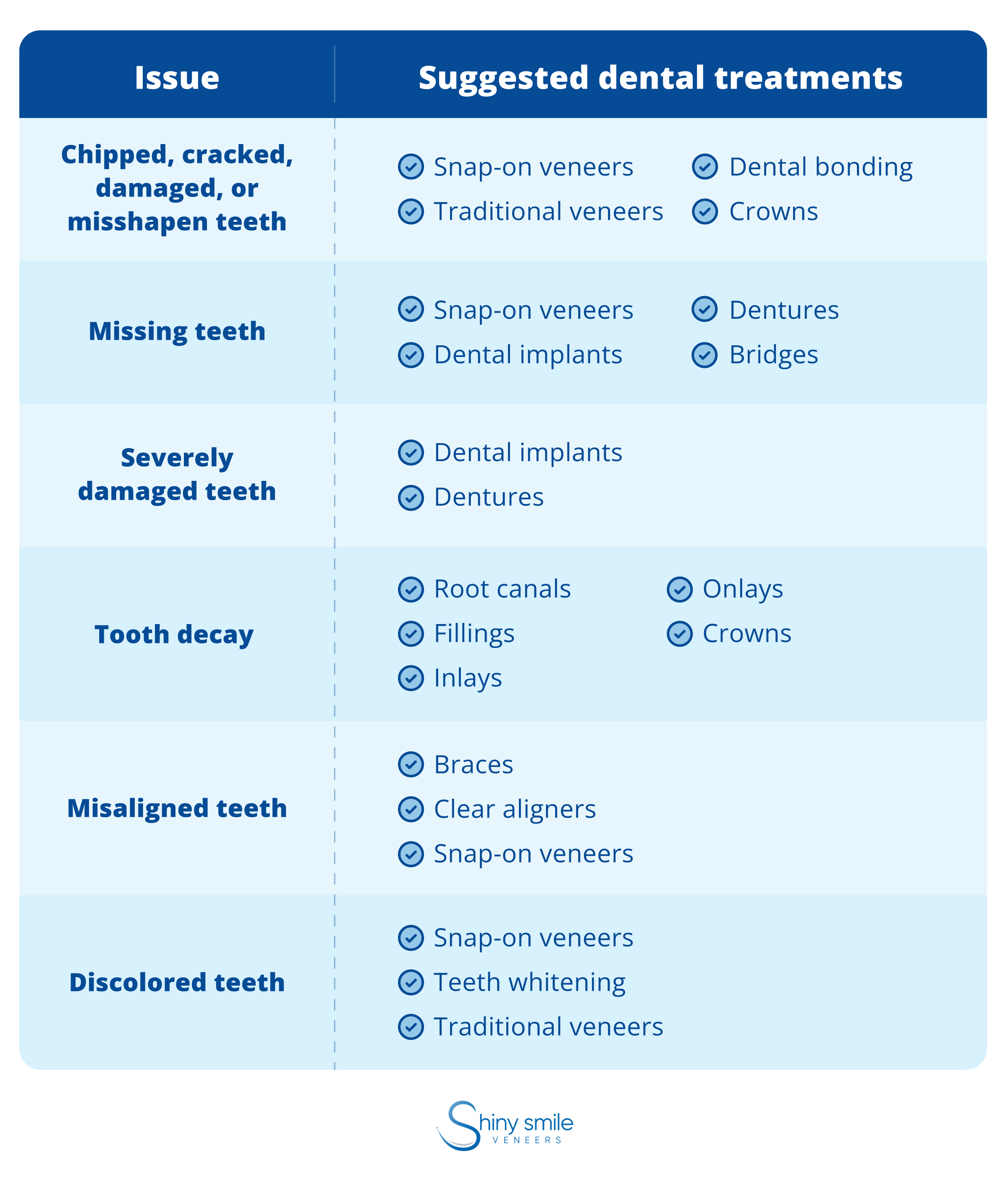
Cosmetic Dental Options to Conceal Bad Teeth
Some cosmetic dental issues can be fixed with the following treatment options:
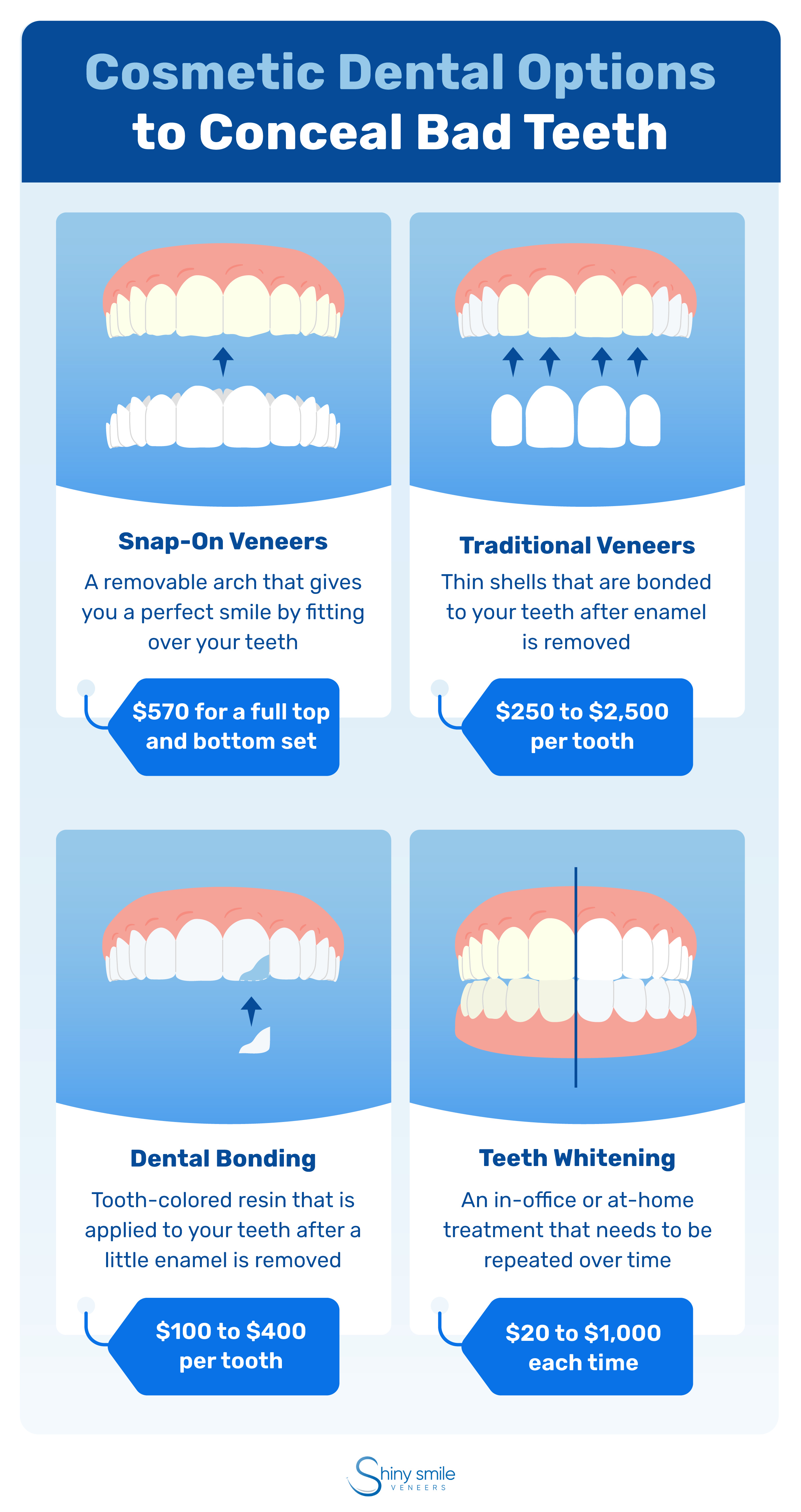
1. Snap-On Veneers
Snap-on veneers can cover tooth loss by fitting a set of false teeth over your real teeth like a mouthguard. You can order your set from home by using an impressions kit, which means you can skip a visit to the dentist’s office or the experience of painful drilling.
With Shiny Smile Veneers, you can get a full veneer set for $570, with payment plans available. You may not get veneers covered by your insurance, but they are the most affordable option if you have bad teeth. They’re also some of the most durable, as snap-on veneers can last one to five years with regular use.
2. Traditional Veneers
Traditional veneers are thin shells that bond to the front of your teeth, and they can conceal some imperfections like cracks, chips, and discoloration. Unlike snap-on veneers, traditional veneers are a permanent solution that requires at least two appointments with the dentist so they can remove some of your natural tooth enamel. This process of getting veneers is also irreversible.
Traditional veneers are either porcelain or resin, with porcelain veneers lasting about 10 to 15 years and costing about $925 to $2,500 for each tooth. Resin lasts five to seven years and costs approximately $250 to $1,500 per tooth. Since traditional veneers are a cosmetic procedure, your insurance may not cover them, costing you money out of pocket.
3. Dental Bonding
Dental bonding can conceal minor imperfections in your teeth and close spaces between teeth. A tooth-colored resin is applied to your teeth, hardened via light, and then shaped to your teeth. Dental bonding takes only one dental visit and removes less enamel than veneers or crowns.
The process of dental bonding takes about 30 to 60 minutes per tooth and can cost between $100 to $400 per tooth. Dental bonding lasts for a while, usually from 3 to 10 years. Since dental bonding can be seen as a restorative treatment, it could be fully or partially covered by your insurance.
4. Teeth Whitening
Teeth whitening is a great option to fix your stained or discolored teeth. You can get whitening done in the dentist’s office, with the dentist applying a high-concentration peroxide bleach gel over periods of 15 to 20 minutes, typically up to an hour. This is one of several ways to get whiter teeth quickly. You can also buy a take-home kit from your dentist so you can whiten your teeth at home. You could also purchase an over-the-counter product, such as teeth whitening strips that you can use every night.
Results can vary, so you may need to get whitening done several times to achieve the look you want. A trip to the dentist’s office for whitening will cost about $1,000 and take-home kits can cost anywhere from $100 to $400. Over-the-counter products are your cheapest options, costing $20 to $100. Whitening is a cosmetic procedure, so you likely can’t get it covered by insurance.
Options to Repair Damaged or Decayed Teeth
If the damage to your teeth is something more than discoloration or stains, then it cannot be fixed with a cosmetic treatment. Here are some ways you can fix various dental issues.
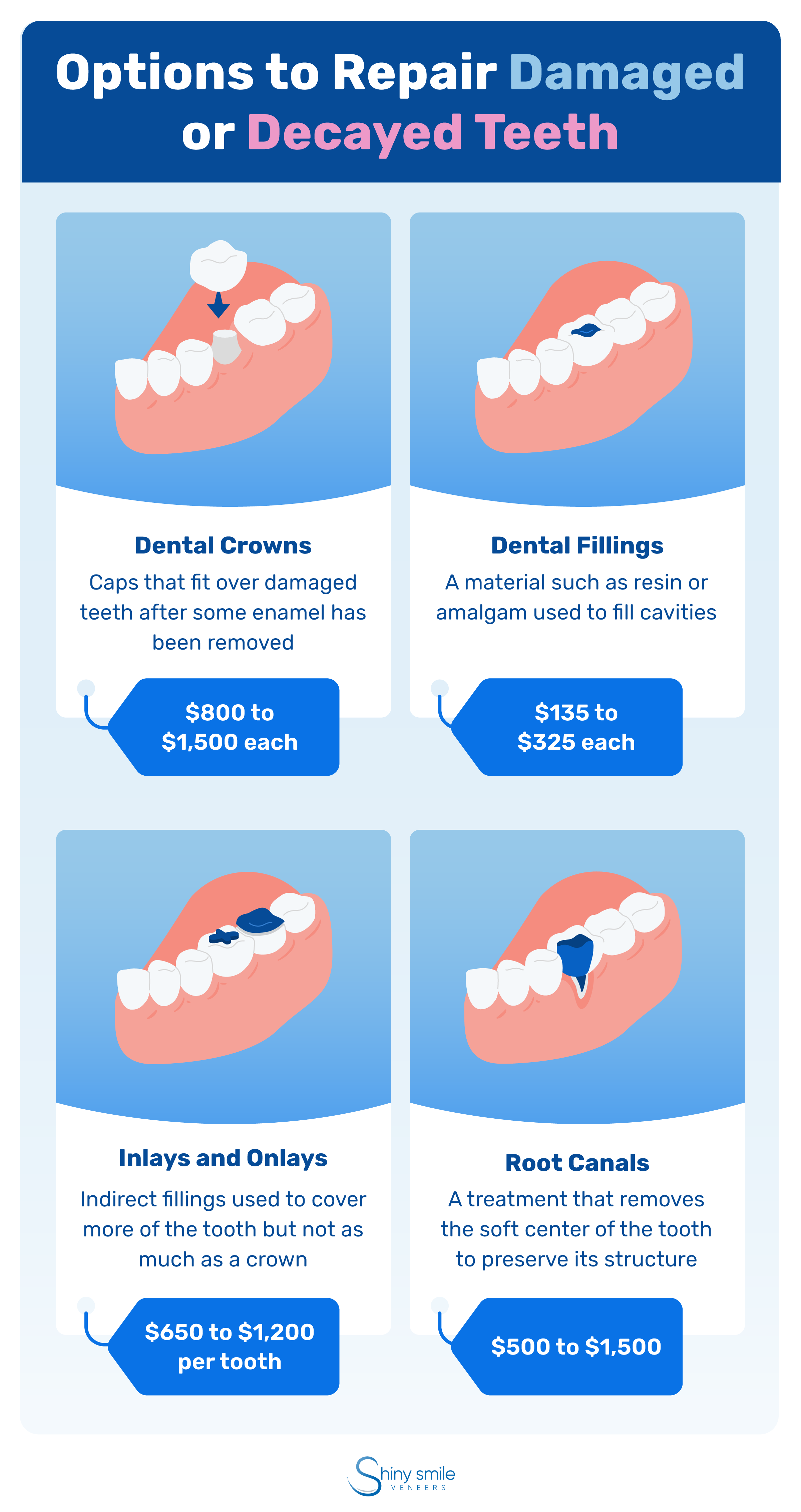
5. Dental Crowns
Crowns can be used to restore a broken tooth or teeth that are weak. Think of crowns as caps that fit over your tooth, once some enamel has been removed.
Crowns are useful because they can be attached to other implants and help with more serious issues since crowns are artificial teeth. Crowns will last between 5 to 15 years, and cost between $800 to $1,500 each, depending on the material used. You could get your crowns covered by insurance if they’re deemed medically necessary for you.
6. Dental Fillings
If you’re suffering from cavities, then dental fillings might be an option for you. Fillings are the individual or combination of materials like gold, porcelain, silver amalgam, or composite resin that can fill those cavities.
The dentist will numb the decayed area and remove the decay or damage in your teeth by drilling. Once the cavity is created, the dentist will add the filling, so your dental filling process is one single visit.
Fillings last 10 to 15 years or longer based on the material used, and costs will also vary based on what kind of filling you get. Composite fillings, or fillings made of multiple materials, cost $135 to $325 each and are typically covered by insurance.
7. Inlays and Onlays
If your dentist mentioned getting an indirect filling, they were simply referring to Inlays or onlays. Since a direct filling is literally filling in a cavity drilled out of tooth decay, you get inlays or onlays when your tooth has enough damage that it can’t support a filling but not enough to warrant a crown.
Indirect fillings come in two forms, depending on how they’re placed on your tooth. If placed on the cusp (chewing surface) of your tooth, it’s an inlay. If covering one or more cusps, it’s an onlay, which may be referred to as a partial crown.
Inlays and onlays are made in a dental laboratory and require two visits before being placed in your mouth. They can be made of resin, porcelain, or gold, and last up to 30 years. Inlays and overlays can cost between $650 to $1,200 per tooth, and this could be covered by your insurance.
8. Root Canals
A root canal is a procedure where the dentist removes the nerves and blood vessels in a single tooth when they become inflamed and infected. This can happen if decay is untreated, your tooth becomes chipped or cracked, or your tooth is injured. The procedure will require anesthetic so your tooth can be opened and sealed.
Costs can range between $500 to $1,500 but vary based on the tooth and the dentist. Root canals are a necessary medical procedure, so your insurance may cover it.
Options to Fix Missing or Severely Damaged Teeth
If you’re suffering from missing teeth or have sustained severe damage, the options below are for you.
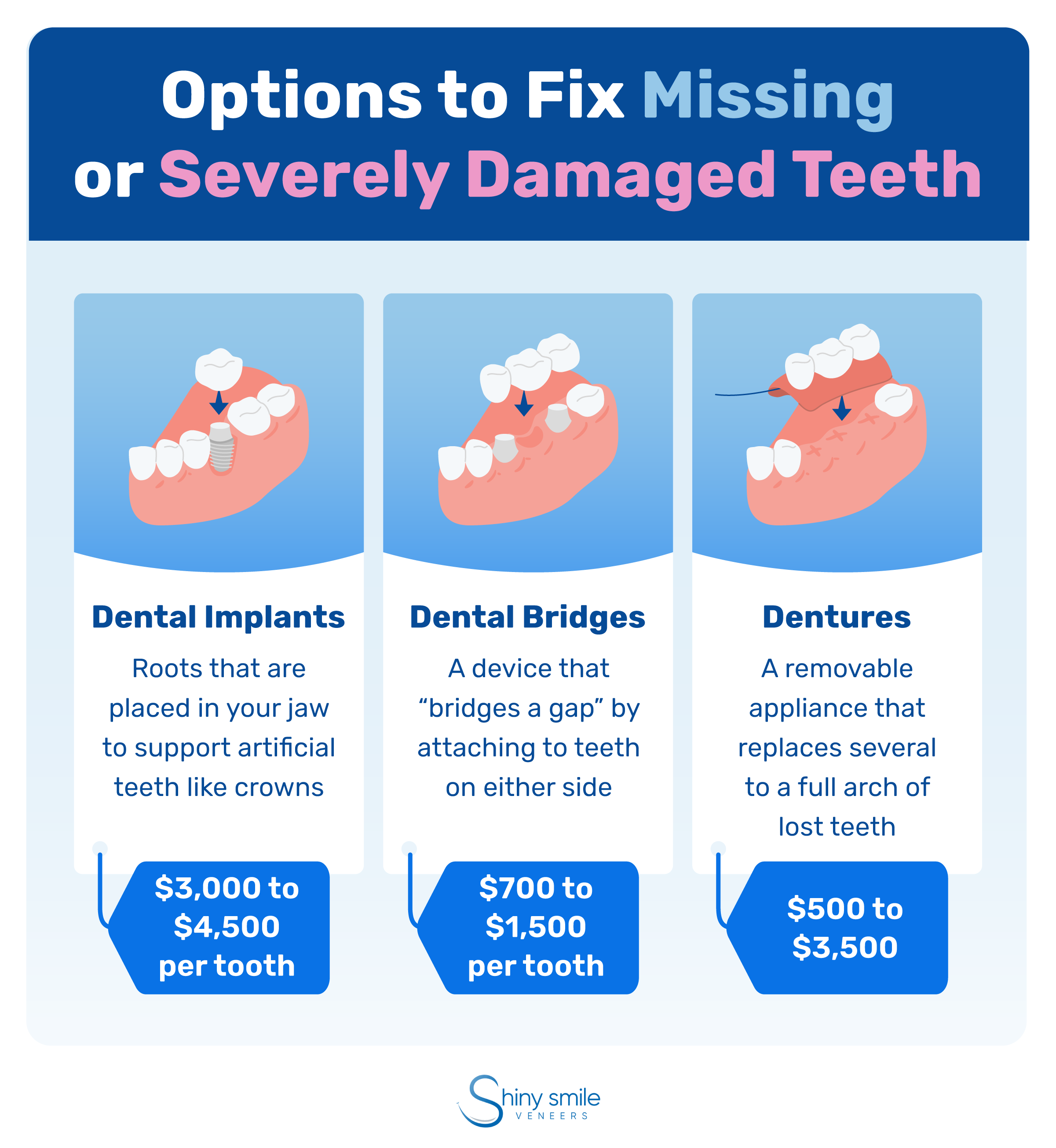
9. Dental Implants
Dental implants are artificial tooth roots that the dentist will place into your jawbone to support artificial teeth like crowns, bridges, and dentures. They can be made of metal and ceramic and can help create a stable foundation upon which you can replace damaged teeth.
The tooth is fully replaced in the jaw with dental implants, so not only does it look like your real teeth, but it also prevents bone loss and any speech impediments you might suffer due to a missing tooth. This procedure is a surgery and could take six weeks to six months to heal.
Implants are expensive, costing between $3,000 to $4,500 per tooth, but they will last a lifetime if you care for them properly. Insurance can help you with payment, as you could get full or partial coverage.
10. Dental Bridges
Dental bridges are another tooth replacement option and are used if you have one or a row of missing teeth. They attach to teeth on either side and cover up the gap. They can be attached in several ways:
- To crowns on either side if you have existing teeth that just need caps placed on top to restore them
- To dental implants if you have a large row of missing teeth
- As metal wings to the back of teeth if bridging front teeth
This process can be painful, and the time it takes to complete will vary based on what the bridge is supported by.
Dental bridges work out to $700 to $1,500 per tooth, although they can be partially covered by insurance. This is a worthy investment, as dental bridges can last 5 to 15 years.
11. Dentures
Dentures are essentially sets of fake teeth. There are four types of dentures, with the first being full dentures, which replace an entire arch of missing teeth and attach to your gums. Partial dentures replace several teeth, whether they’re in the same row or spaced out. Implant-retained dentures attach to dental implants for extra stability, while implant-supported dentures attach to implants but can only be removed by a dentist.
Dentures are a good option for you if you have lots of missing teeth since they can stop your facial muscles from sagging from the lack of teeth. You will most likely need to remove dentures at night unless you have implant-supported dentures.
You will need to evaluate your dentures every five years so that you can be sure you have the best fit. Dentures can cost $500 to $3,500 depending on the type, although many dental insurance policies will cover some or all of the cost of dentures.
Options to Align Teeth
You may not be struggling with a cavity or discoloration, but crooked teeth may be just as annoying. Thankfully, there are several options for you to fix and align your teeth.
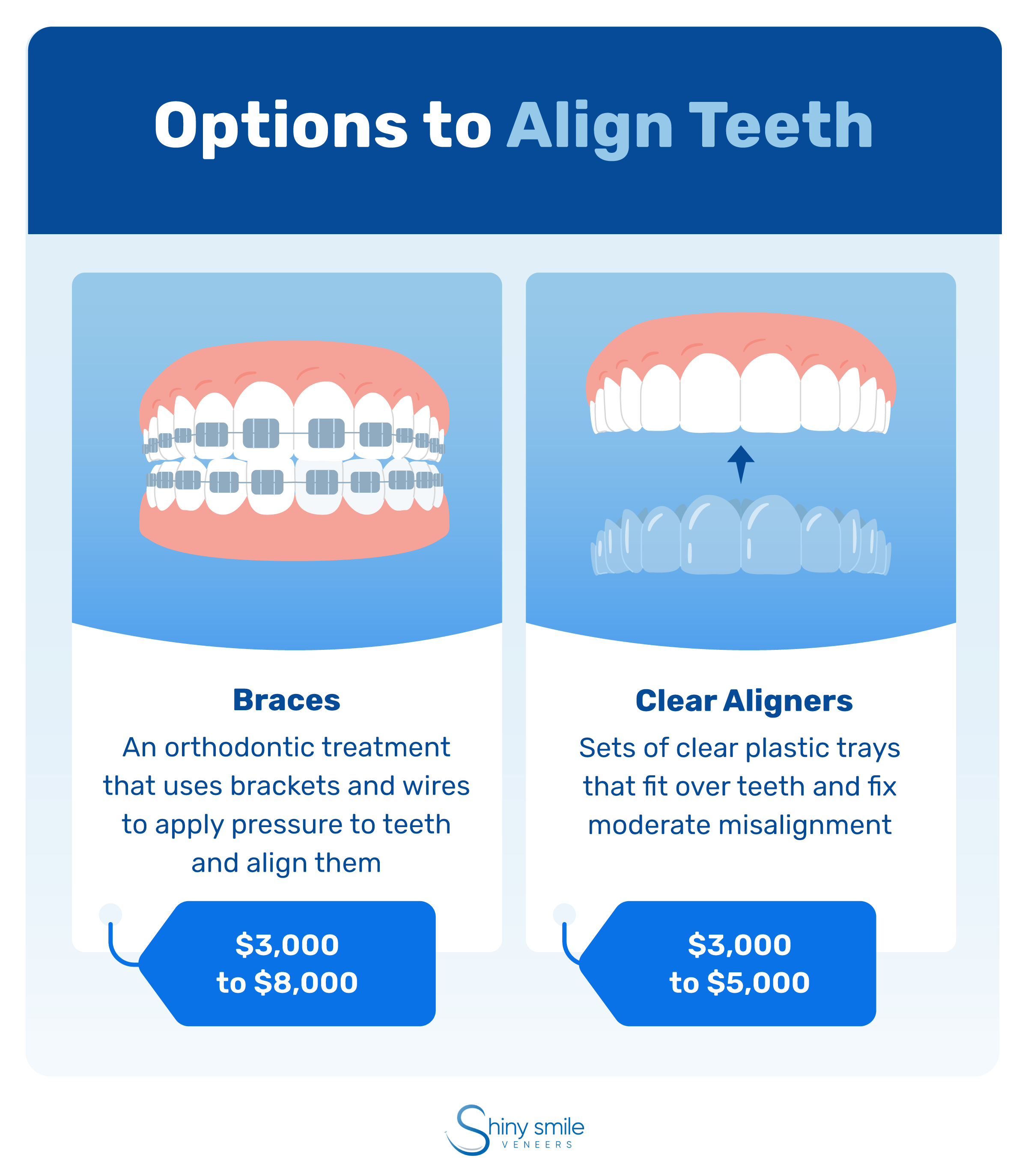
12. Braces
Braces are a common fix for dental problems like crooked teeth in both children and adults. Traditional braces are made of metal brackets that are fixed to the front of your teeth with a wire threaded through them. This wire is tightened so that it realigns your teeth.
Some other kinds of braces are less noticeable and more comfortable. Ceramic braces use tooth-colored brackets, thus concealing the fact you have braces. Lingual braces are the same as traditional brackets, but they are fastened to the back side of your teeth so that they’re essentially invisible. Finally, self-ligating braces hold the archwire in place with clips so that you feel less discomfort.
No matter what kind of braces you wear, you will need them for about one to three years and they’ll cost about $3,000 to $8,000. Of course, the price and length of treatment depend on the severity of your issue. Keep in mind that braces for adults are typically not covered by medical or dental insurance, although it depends on your policy.
13. Clear Aligners
Clear aligners like Invisalign, as well as alternatives like ClearCorrect and SureSmile are made out of clear plastic so that they’re less noticeable than normal braces. These aligners fit over your teeth and put pressure on them to correct them. While they can fix mild issues, clear aligners may not be suitable for more complex cases.
Impressions are made of your teeth and used to make custom clear aligners, which your dentist will give to you every four to six weeks at regular check-ups. You have to wear them at least 20 hours a day, and treatment may take less than a year, although you need to wear a retainer afterward.
Invisalign costs $3,000 to $5,000 on average in the U.S., but the cost depends upon your needs. You could get your clear aligners covered by dental insurance if your policy covers other treatments like traditional braces.
Why Shiny Smile Veneers Are the Best Solution for Bad Teeth
So, if you’re self-conscious and suffering from bad teeth and are considering veneers or dentures, take a long look at Shiny Smile Veneers. While snap-on veneers will not be able to repair severe medical issues, they are the perfect cosmetic option to improve your smile.
- They’re affordable. A full set of veneers costs $570, while a single arch costs $370. They are by far the cheapest option for fixing rows of teeth, while finance plans and the industry’s 15-month veneer-only warranty are also available.
- They’re realistic. There are several shades available, which all look like real teeth. You can eat and speak normally while wearing them, greatly boosting your self-esteem.
- There’s no need to see a dentist. With snap-on veneers, you don’t need to schedule appointments or go through all the painful drilling that other options require. You can complete the entire process from home in several easy steps. Simply order and complete the impression kit, take pictures of your teeth, and snap on those veneers once you receive them.
- They won’t damage your teeth. Unlike other options that require enamel to be removed, Shiny Smile veneers won’t change your teeth in any way. You can remove them whenever you want, and you don’t need a dentist to take them out either.
Get a Confident Smile Today
If you’re ready to get your beautiful smile back today, check out Shiny Smile Veneers. Just select a veneer shade and order your impression kit, and you can begin smiling with self-confidence today.